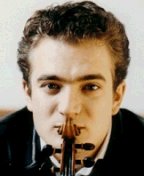Les Frères Capuçon, Shriver Hall
 |  |
I suspected that Argerich's mantle indicated great talent in those upon whose shoulders it rested, and I was not disappointed. The two young Frenchmen are brothers born in Chambéry, the former seat of the Dukes of Savoie up in the French Alps. The program featured four pieces in that rare genre, duets for unaccompanied violin and cello, further organized around the theme of gypsy and general folk music. This is music for the connoisseur, not a single piece that could be called truly popular, and in fact it was the first time that I had heard any of these pieces performed live. As for many in the largely unfilled hall, most of these pieces came as a revelation in the hands of these talented players.
Kremerata Baltica at Shriver Hall (May 3, 2005) Takács Quartet and Garrick Ohlsson at Shriver Hall (October 4, 2005) |
 You would have thought that the next piece, Ravel's Sonata for Violin and Cello (1920-22), would have been out of place in a program of eastern European composers. However, dedicated to the memory of Claude Debussy, this piece is not your father's Ravel, with sounds that we might expect more in Bartók or Stravinsky. In fact, when he was working on this piece, Ravel was closely following the composition and folksong research that Bartók was doing in Hungary. He was also studying the Kodály violin-cello duo, which closed this concert. In the opening allegro, Ravel presents a soft, pastoral folk theme in a sort of overlapping stretto that ends on a calm set of shining triads. Gypsy sounds not unlike what we heard in the Schulhoff invade the second movement, with its pulsating Stravinskian rhythms. Both the sad beauty of the third movement and the exciting drive of the last impressed.
You would have thought that the next piece, Ravel's Sonata for Violin and Cello (1920-22), would have been out of place in a program of eastern European composers. However, dedicated to the memory of Claude Debussy, this piece is not your father's Ravel, with sounds that we might expect more in Bartók or Stravinsky. In fact, when he was working on this piece, Ravel was closely following the composition and folksong research that Bartók was doing in Hungary. He was also studying the Kodály violin-cello duo, which closed this concert. In the opening allegro, Ravel presents a soft, pastoral folk theme in a sort of overlapping stretto that ends on a calm set of shining triads. Gypsy sounds not unlike what we heard in the Schulhoff invade the second movement, with its pulsating Stravinskian rhythms. Both the sad beauty of the third movement and the exciting drive of the last impressed.Instead of the scheduled third piece -- Gideon Klein's Duo for Violin and Cello -- the Capuçon brothers substituted a little Ionarts bonbon, Bohuslav Martinů's Duo No. 2 for Violin and Cello, one of the last pieces he composed, in 1958. (He had written one other piece for this combination of instruments, some thirty years before.) These three movements were commissioned by a musicologist in Basel, as a gift for his wife's name day, and they are over pretty quickly but not without much diversion for the ear. Martinů also uses a folklike melody, over a cello drone in the short first movement. The rush to the piece's ecstatic conclusion was exciting to hear.
| Available at Amazon: Renaud Capuçon and Gautier Capuçon, Face à face (duos for violin and cello), released July 8, 2003 |
Looking at the schedule of upcoming concerts at Shriver Hall, we are going to be driving up to Baltimore a lot in the next couple months. The Vienna Piano Trio (February 26, 5:30 pm), Jordi Savall with Hesperion XXI (March 19, 5:30 pm), Krystian Zimerman (April 7, 8 pm), Leon Fleisher (April 8, 8 pm), Fazil Say (April 9, 3 pm), and Angela Hewitt (May 14, 7:30 pm) are all well worth your while.
UPDATE:
The Baltimore Sun allowed 112 words to give their readers a review of this concert. Scroll down to the bottom of the article -- by Tim Smith on January 31, covering several concerts together -- to find it. That is the only other review I have seen.





















































No comments:
Post a Comment